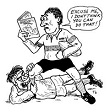Principle
If a team gains an advantage following an infringement by their opponents, the referee may allow play to continue in an effort to keep the game flowing.
1. Advantage:
a. May be tactical. The non-offending team is free to play the ball as they wish.
b. May be territorial. Play has moved towards the offending team’s dead-ball line.
c. May be a combination of tactical and territorial.
d. Must be clear and real. A mere opportunity to gain an advantage is not sufficient.
2. Advantage ends when:
a. The referee deems that the non-offending team has gained an advantage. The referee allows play to continue; or
b. The referee deems that the non-offending team is unlikely to gain an advantage. The referee stops the game and applies the sanction for the infringement from which advantage was being played; or
c. The non-offending team commits an infringement before they have gained an advantage. The referee stops the game and applies the sanction for the first infringement. If either or both infringements are for foul play, the referee applies the appropriate sanction(s) for the offence(s); or
d. The offending team commits a second or subsequent infringement from which no advantage can be gained. The referee stops play and allows the captain of the non-offending team to choose the most advantageous sanction.
3. Advantage must not be applied and the referee must blow the whistle immediately when:
a. The ball or a player in possession of the ball, touches the referee and an advantage is gained by either side.
b. The ball comes out of either end of the tunnel at a scrum.
c. A scrum is wheeled through more than 90 degrees.
d. A player in a scrum is lifted or forced upwards so that the player is no longer in contact with the ground.
e. A quick throw, free-kick or penalty is taken incorrectly.
f. The ball is made dead.
g. It would be dangerous to let play continue.
h. It is suspected that a player is seriously injured.
- 6 weergaves
